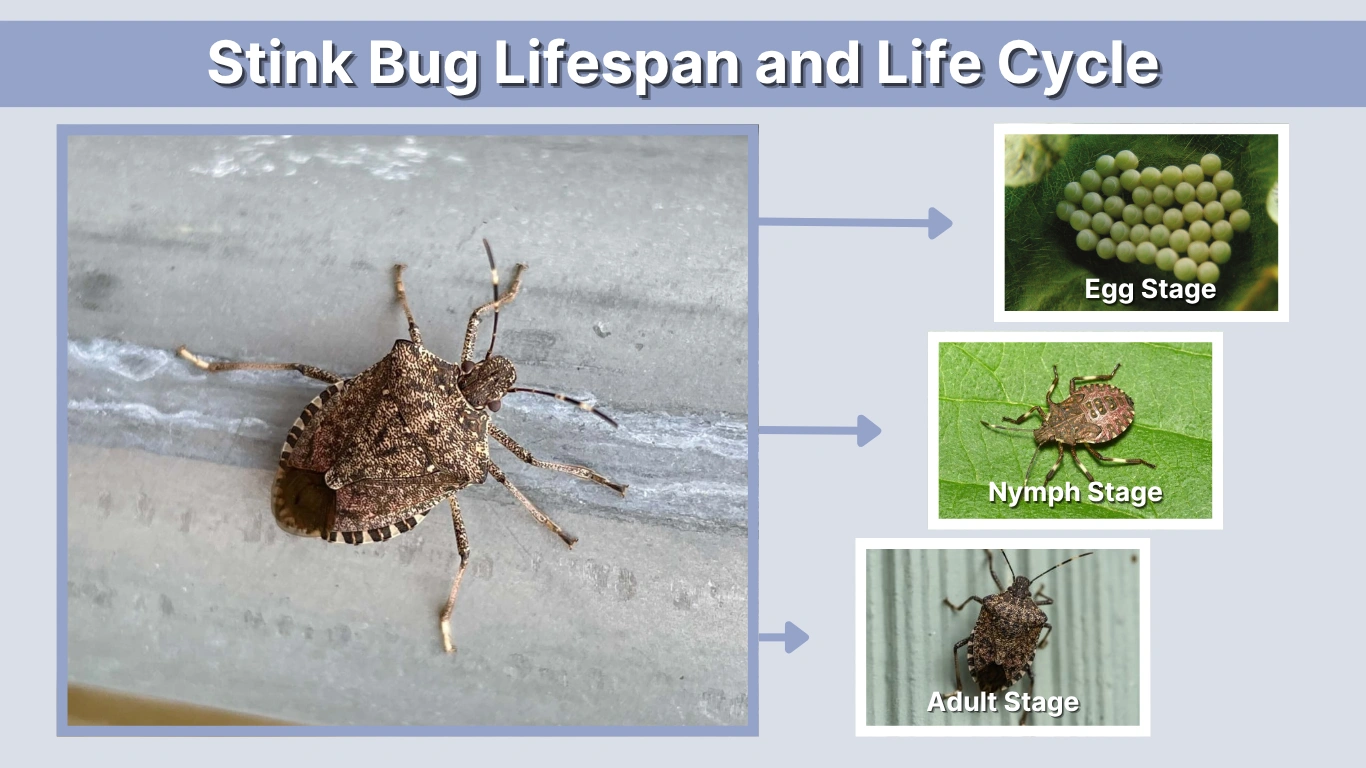The stink bug, scientifically known as Halyomorpha halys, is a hardy insect that can adapt to a wide range of environments. Known for its strong odor and shield-like shape, it thrives outdoors during warm months and often enters homes in fall to escape the cold. Many people wonder how long stink bugs actually live — whether indoors, outdoors, or without food and water. Their lifespan varies depending on species, climate, and living conditions, but most stink bugs survive six to ten months on average.
Average Lifespan of a Stink Bug
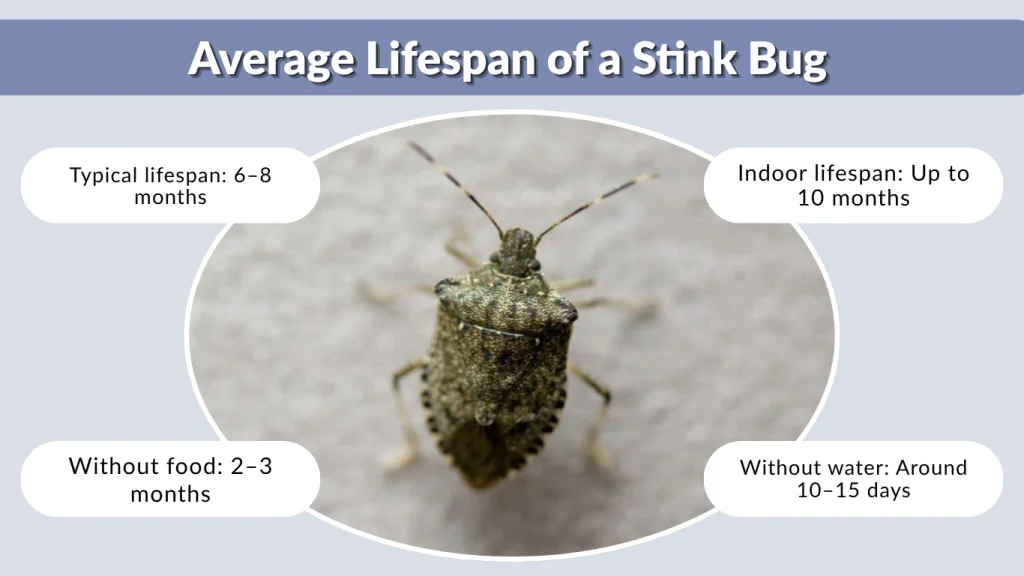
Stink bugs have surprisingly long lifespans compared to many other insects. On average, they live between six and ten months, though some can survive up to a full year in ideal environments.
Their longevity depends largely on access to food, water, and shelter. In warm, humid regions, such as the southern United States, stink bugs tend to live longer because they can feed and reproduce for extended periods. In colder areas, many enter a dormant state known as diapause, which helps them survive months without food during winter.
Quick breakdown of lifespan:
- Typical lifespan: 6–8 months
- Indoor lifespan: Up to 10 months
- Without food: 2–3 months
- Without water: Around 10–15 days
- In captivity: Up to 12 months with proper care
Factors That Affect How Long Stink Bugs Live
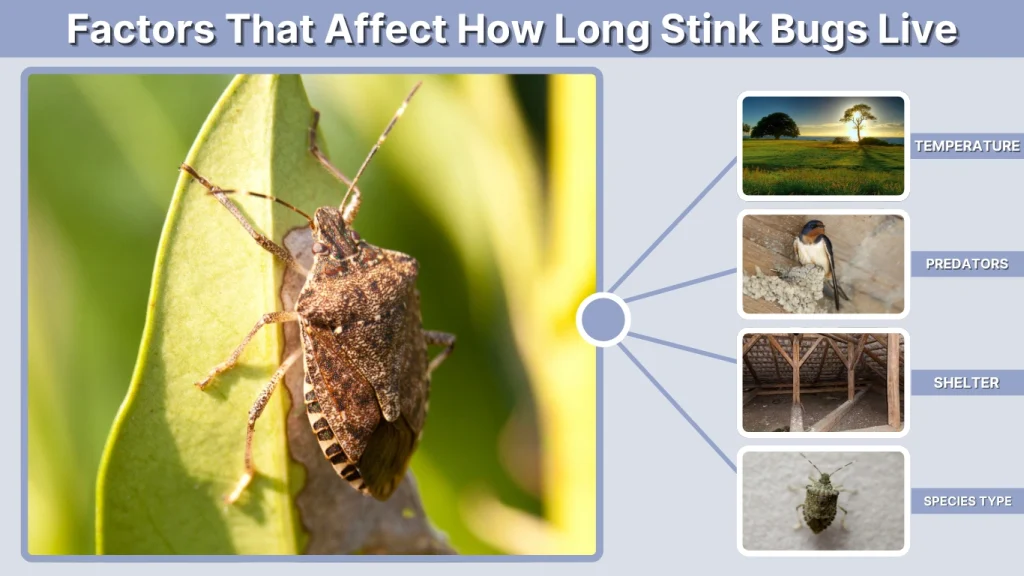
Several environmental and biological factors determine how long a stink bug will live.
Key influences include:
- Temperature: Warm climates extend lifespan, while cold can shorten it.
- Food availability: Regular access to fruit and plant sap helps them stay active longer.
- Predators: Birds, wasps, and spiders reduce their survival outdoors.
- Shelter: Homes, attics, and barns provide safe hiding spaces that allow longer survival.
- Species type: Brown marmorated stink bugs usually outlive green or southern varieties.
In stable indoor environments, they face fewer threats, leading to much longer lives than those exposed to outdoor conditions.
Life Cycle of a Stink Bug
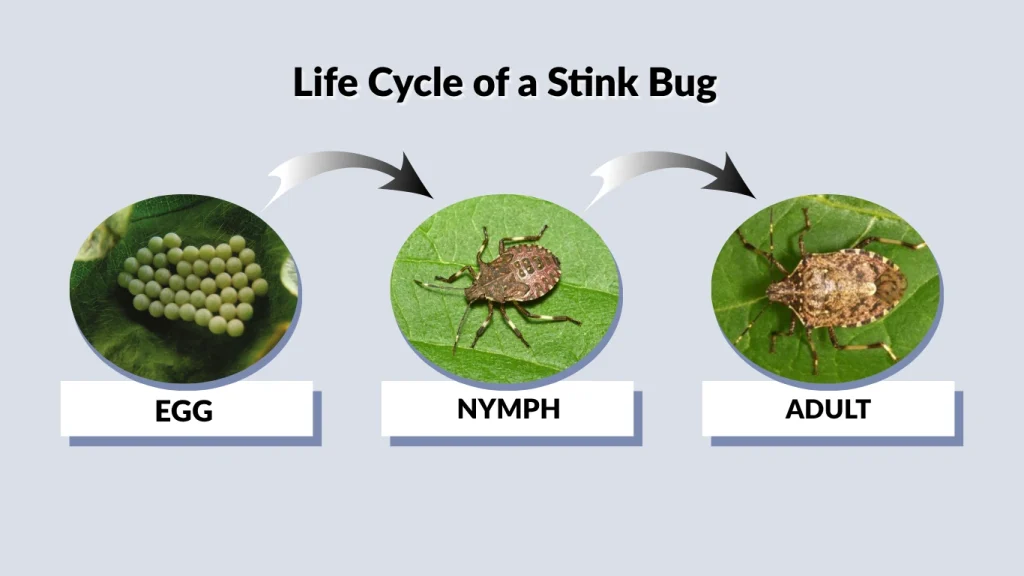
Like many insects, the stink bug undergoes a three-stage life cycle: egg, nymph, and adult. The full process typically spans four to six weeks, though adults live much longer afterward.
Egg Stage
Female stink bugs lay eggs on the underside of leaves, usually in clusters of 20–80. These barrel-shaped eggs hatch within four to seven days depending on temperature. Warmer conditions speed up hatching, while cooler weather slows it down.
Nymph Stage
After hatching, young stink bugs — called nymphs — are wingless and smaller, with bright markings ranging from orange to black. They pass through five developmental stages, or instars, over the course of 30–45 days. During this time, they feed actively on plant sap to grow and molt into adults.
Adult Stage
Once mature, stink bugs develop wings and their characteristic shield shape. Adults can live six to ten months, reproducing multiple times per season. When winter arrives, they seek sheltered areas such as under bark, inside sheds, or within homes to survive until spring.
How Long Do Brown Marmorated Stink Bugs Live?
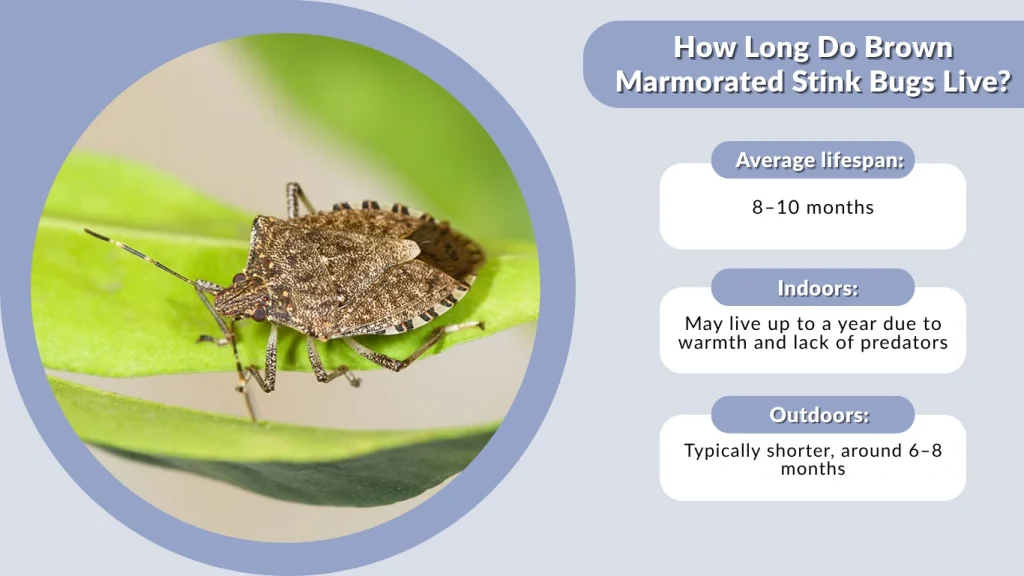
The brown marmorated stink bug (Halyomorpha halys), the most common indoor species in North America, has one of the longest lifespans in the stink bug family.
- Average lifespan: 8–10 months
- Indoors: May live up to a year due to warmth and lack of predators
- Outdoors: Typically shorter, around 6–8 months
These bugs emerge in spring, feed on crops through summer, and move indoors in fall to overwinter. Once inside, their slowed metabolism allows them to survive long periods without food, often until the next spring.
How Long Do Green Stink Bugs Live?
The green stink bug (Chinavia hilaris) is another widespread species, especially in warmer regions. Its lifespan is generally six to eight months, slightly shorter than its brown counterpart. Green stink bugs are more active outdoors, feeding on fruits and vegetables throughout the growing season. Because they spend less time overwintering indoors, their overall lifespan tends to be shorter, though they reproduce more frequently in tropical areas.
How Long Do Stink Bugs Live Indoors?
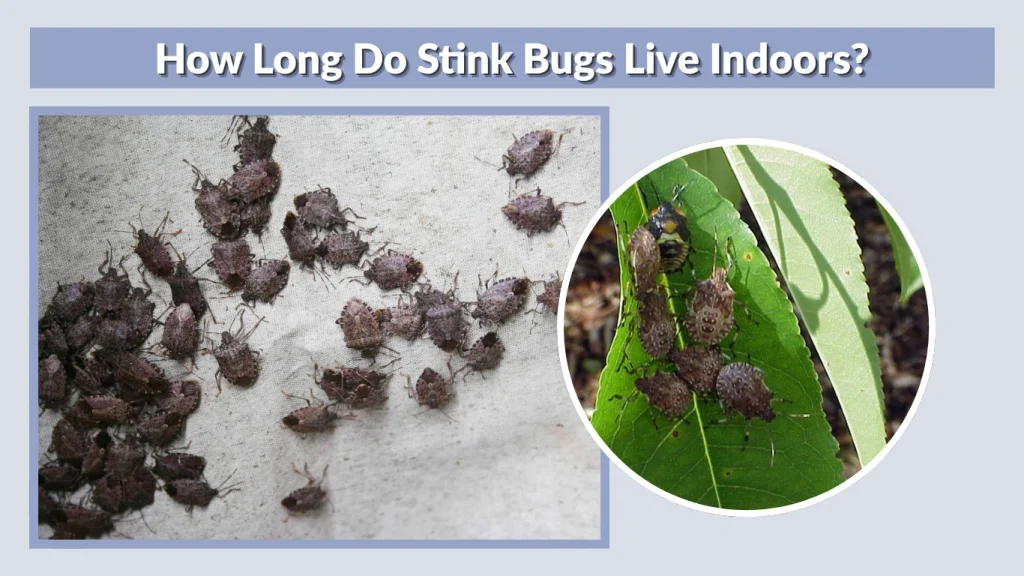
Stink bugs can live much longer indoors than outdoors. Once they enter homes in the fall, they stay protected from harsh temperatures and predators. Inside, they typically hide in wall cracks, attics, and basements, remaining inactive throughout the winter months.
Indoors, their lifespan can extend to around 9 or 10 months.
Even without food, they survive for months by slowing their metabolism in a hibernation-like state known as diapause. When heating systems or warmer spring air wakes them, they begin to crawl out of hiding and may appear near windows or lights.
Although they live longer indoors, stink bugs do not reproduce inside homes. Their extended life is due to warmth and safety, not breeding activity.
How Long Do Stink Bugs Live Without Food or Water?
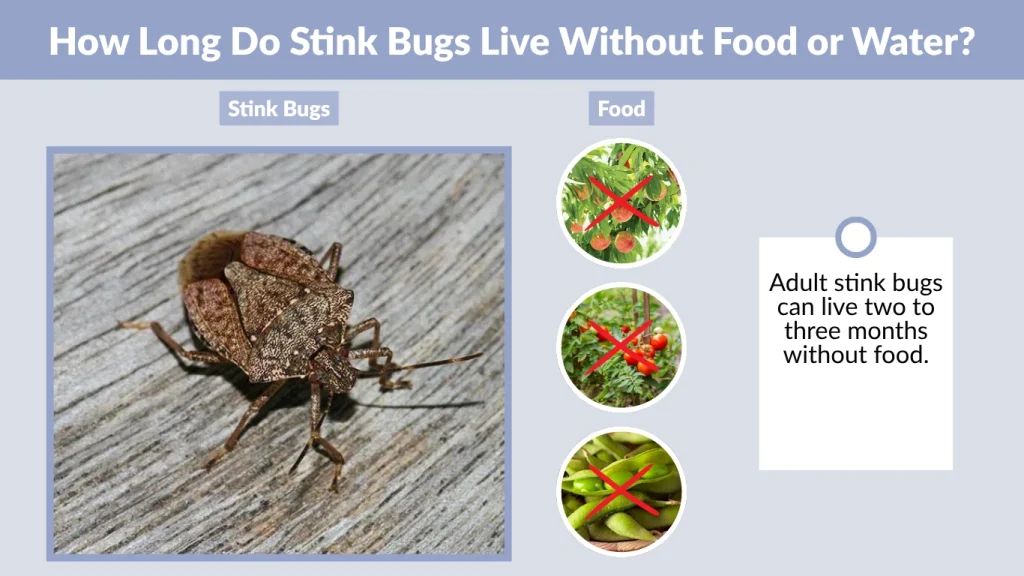
One of the most fascinating traits of stink bugs is their ability to survive without eating for long periods. Their energy-efficient bodies and slow metabolism help them endure harsh conditions.
Without Food
Adult stink bugs can live two to three months without food, especially when in diapause. Outdoors, they feed on fruit, seeds, and plants, but indoors they simply rest until spring.
In warm, active environments — like heated rooms — they burn more energy, shortening their survival time to just a few weeks.
Without Water
Without moisture, stink bugs survive 10 to 15 days before dehydrating. However, they can absorb small amounts of humidity from the air, which extends their lifespan slightly indoors.
Summary Table:
| Condition | Survival Duration |
| Normal outdoor environment | 6–8 months |
| Indoors (warm, protected) | 8–10 months |
| Without food | 2–3 months |
| Without water | 10–15 days |
| In captivity (with care) | Up to 12 months |
How Long Do Stink Bugs Live in Captivity?
When kept for observation or research, stink bugs live the longest. Under stable conditions — around 70–80°F and 50–60% humidity — they can survive up to one year.
Entomologists provide them with fruits, vegetables, and plant leaves for food and small amounts of water or mist for hydration.
Their longer life in captivity demonstrates how much warmth, humidity, and consistent nutrition contribute to extending their natural lifespan.
How Long Do Stink Bugs Live in a House or Apartment?

If you keep finding stink bugs in your home during winter or early spring, it’s likely the same bugs that entered months earlier.
Once inside, they:
- Hide in attics, wall voids, and ceilings.
- Enter diapause, conserving energy.
- Can live up to 9–10 months before dying naturally.
They don’t reproduce indoors, but pheromones released by one stink bug can attract others to the same area. This is why infestations seem to reoccur yearly — the scent signals remain even after the original bugs are gone.
Do Stink Bugs Hibernate or Overwinter?
Yes. Stink bugs enter a dormant state during winter to survive until warmer weather returns. This period, called overwintering, allows them to reduce energy use drastically.
During overwintering:
- They become sluggish and stop feeding.
- They seek shelter in bark crevices, sheds, or inside homes.
- Their lifespan effectively pauses, resuming once temperatures rise.
In spring, they awaken, feed briefly, and reproduce before dying naturally by late summer. This survival cycle allows the species to persist even through extreme temperature changes.
Do Stink Bugs Live Longer Indoors or Outdoors?
Generally, stink bugs live longer indoors because they are shielded from temperature swings, predators, and food shortages.
| Environment | Average Lifespan | Explanation |
| Outdoors | 6–8 months | Exposed to weather, predators, and food scarcity |
| Indoors | 8–10 months | Protected environment extends survival |
While living indoors helps them survive longer, it’s not a natural part of their life cycle. Once spring arrives, they attempt to leave in search of food and mates.
What Happens When Stink Bugs Die Indoors?
Stink bugs often die quietly in hidden areas such as window sills, basements, and attics. Their bodies dry out quickly, leaving behind a faint odor that can linger. Dead stink bugs might attract other small insects like ants or beetles, so it’s best to vacuum or sweep them up promptly.
Their death usually marks the end of their life cycle — adults rarely live beyond one year.
FAQs
How long do brown marmorated stink bugs live?
They typically live 8–10 months, surviving longest indoors or in mild climates.
Can stink bugs live without food or water?
Yes. They can last two months without food and up to two weeks without water, depending on temperature and humidity.
Do stink bugs die in winter?
Many die outdoors, but those that find shelter inside homes can survive until spring.
Do green stink bugs live as long as brown ones?
No. Green stink bugs usually live 6–8 months, shorter due to their outdoor activity levels.
Can stink bugs live for a year?
Yes, under ideal indoor or captive conditions, some can survive close to a full year.

